The Academy of the New Church
An Historical Sketch
C. Th. Odhner
Back to: Part 1: A Glimpse at Bryn Athyn
Origin of the Movement for New Church Education
Movements Preperatory to the Academy of the New Church
Organization of the Academy
The Academy Enters Upon the Use of Education
The Schools at Cherry Street
Social Life
"Our own Academy"
"Alma Mater"
Origin of the Movement for New Church Education. top
The movement for distinctive Education in the New Church arose simultaneously with the first distinctive establishment of the New Church itself in Great Britain, as may he seen from the following resolutions adopted by the First General Conference of the New Church, in 1789:
- —Resolved Unanimously:
That it is the Opinion of this Conference, that the Doctrines and Worship in the Old Church are highly dangerous to the rising Generation, inasmuch as they tend to implant in Young People the Idea of Three Divine Persons, to which is unavoidably annexed the Idea of Three Gods; the consequence whereof is Spiritual Death to all those who confirm themselves to such an opinion. - —Resolved Unanimously:
That it is the opinion of this Conference, that it is the Duty of every true Christian to train up his children in the Principles and Heavenly Doctrines of the New Jerusalem Church alone, the two grand Essentials of which are, I. That the Lord and Saviour Jesus Christ is the only God of Heaven and Earth, and that His Humanity is Divine. II. That in order to Salvation on, Man must live a Life according to the Ten Commandments, by shunning Evils as Sins against God.
The subject was introduced only incidentally, however, on that occasion, and for several years nothing further was heard respecting it. The interests of the earliest members of the Church were in general occupied with the absorbing desire to make the Heavenly Doctrines known to the world at large, and in this field of work they performed a great and necessary use. But, alas, in the meantime many, if not most of them. failed to present these heavenly treasures to their own children. It was generally supposed that the Doctrines of the New Church were not adapted to the comprehension of the young, or that parents had not the right to influence their children in the choice of a religion.
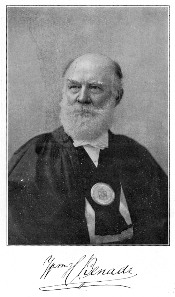
William H. Benade
Click on image for a larger version.
The results of this neglect, or mistaken policy, began to become evident some thirty years after the first establishment of the Church, when, in the early periodicals, there were heard voices of alarm at the deplorable fact that most of the children of the New Church parents were returning to the denominations of the Old Church, or had grown up without any active interest in the things of religion. It was the Rev. Robert Hindmarsh, the founder of the New Church as an external organization, who first suggested the establishment of distinctive schools of the Church as the remedy against this grievous evil. Certain experiments were made in the way of New Church educational institutions, but they quickly failed, from lack of experience and financial support.
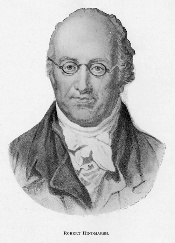
Robert Hindmarsh
Click on image for a larger version.
During one generation after another, the Church continued to lose most of those who naturally should have been the immediate source of her increase. The founders of the Church passed away, but, except in a very few cases, the voices of their children or grandchildren were never heard in the streets of the New Jerusalem. Their places were filled by strangers who, in their turn, failed to recognize fully their primary duty to their children. Sunday Schools were established, it is true, but these have proved insufficient as substitutes for careful and systematic religious training, day, by clay, in the New Church Home and the New Church School. The general missionary work has continued to absorb the attention and energies of the Church, but the results have not at all corresponded to the efforts. The tendency has been to present the Doctrines to those who are least open for reception; the Clergy of the various sects, and the adult minds in the intellectual world, in other words, those who are especially confirmed in the false principles and the life of the Old Church; and this unpromising field is still being cultivated in spite of its poor returns, and in spite of the well-known and significant fact that by far the greater proportion of the present members of the New Church consists of such as have received the Doctrines in youth or early manhood. It is generally conceded that the numerical increase, and at the same dine the spiritual growth of the Church, have thus far been disappointing. On the other hand, it is not difficult to imagine what would have been the present condition, had all the descendants of New Church parents remained in the Church. Not only would the membership of the whole Church be many times larger than at present, (as may be demonstrated by a simple arithmetical calculation, on the reasonable basis that each family may have at least two children, four grandchildren, and eight great-grandchildren), but there would have been also a corresponding spiritual increase, as each generation, instead of always starting de novo as new receivers, by hereditary inclinations and by progressive education would have cultivated the faith and the life of the New Church on ever more internal planes. But though things are not what they might have been, there is no reason for discouragement, for it is never too late to begin anew, and to strive for a healthier state by the simple, practicable, and Divinely ordained means of educating the young in the New Church, distinctly by and for the Church.
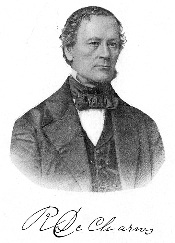
R DeCharms
Click on image for a larger version.
The budding idea of New Church Education, though it was never entirely lost in Great Britain, found a somewhat more ready reception when transplanted to American soil. The Rev. Richard de Charms, who had pursued his theological studies in London under the guiding influence of Robert Hindmarsh and Samuel Noble, was the first earnest advocate of New Church Education in this county. Directly or indirectly owing to his persistent propaganda, New Church dayschools were established by a few societies, the movement finally culminating in the foundation of the Urbana University, in Ohio, in 1851. For some years these schools worked with considerable success, but before long most of them were invaded by the proselytizing spirit. In the hope of making converts, and in some cases for financial reasons, their doors were opened to children of Old Church parents. As the next step, the instruction in the Doctrines of the New Church was made a matter of choice instead of remaining an essential sine qua non. The schools thus lost their distinctive character and became New Church for the most part in name only. Many went out of existence before long; a few developed into purely secular institutions.
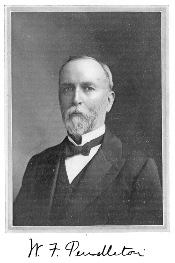
W. F. Pendleton
Click on image for a larger version.
As thus developing, these schools did not fulfill the ideals of Mr. de
Charms and his associates, but the object was not given up. The subject
of New Church Education was much discussed in the "Central Convention,"
of which Richard de Charms, David Powell and N. C. Burnham were the leading
spirits, and this body, in 1844, passed a resolution declaring the establishment
of a complete New Church Seminary to be one of the most important uses
to which the Convention could devote its best and most enduring energies.
But the means towards this great end were not vet at hand, and the Central
Convention itself was dissolved in the year 1852, by its last resolution
bequeathing its most cherished possession, (an original oil-portrait of
Swedenborg), to the first New Church Academy that should be established
in the future in what were then termed the "Middle States."
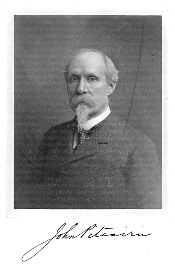
John Pitcairn
Click on image for a larger version.
Movements Preperatory to the Academy of the New Church. top
The Central Convention passed away, Mr. de Charms passed away, but the idea of New Church Eduction slid not pass away Mr. de Charms' mantle fell upon a worthy pupil and successor, the Rev. William Henry Benade, with whom this idea became an all-inspiring motive.
When, in 1854, Mr. Benade was chosen pastor of the newly organized "Philadelphia Society," a building was erected by this society at the north-eastern corner of Cherry and Claymont streets, distinctly and avowedly for the primary use of New Church Education. The upper story of this building was arranged for worship, but in the lower story rooms were fitted up for the New Church day-school which was established there in 1836. This was the first School ever conducted according to the general principles which have been adopted by the Academy. Among the teachers in this School Mr. Benade, Dr. Leonhard Tafel and Mr. Herman Faber subsequently taught also in the Schools of the Academy. The little School worked faithfully and not without success, until it was discontinued in 1863, owing to the disturbing influences of the Civil War and other causes. Mr. Benade now became pastor of the society in Pittsburg, where, under his teachings, there grew up a generation of vigorous and earnest young laymen who had the cause of New Church Education warmly at heart.
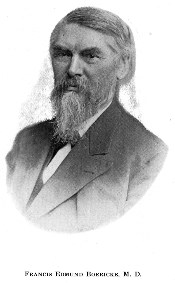
Francis Edmund Boericke, M.D.
Click on image for a larger version.
We must now digress for a moment in order to explain the spiritual principles and causes which immediately led up to the establishment of the Academy of the New Church.
The idea of New Church Education was the offspring of two most important parent principles of New Church faith, which, during the course of the past century, became more and more clearly recognized by a few as essential and indispensable for the establishment of the New Church on a firm and sound foundation. The first of these principles was the practical acknowledgments of the Lord Jesus Christ in His Second Coming: that He is present with His Church in and by the Revelation of Divine Truth which has been given in the Theological Writings of His Servant Emanuel Swedenborg, the rational yet inspired enfolding of the Internal sense of the Word and the Heavenly Doctrine of the New Jerusalem. This acknowledgment involved the recognition of the Divine and therefore infallible Authority of these Writings, as being the Voice and Word of God Himself, and not of a mere man. And the second of the two fundamental principles was the recognition of the complete Distinctiveness of the New Church, the necessity of its separation from the Old Church in all things, internal and external. This involved the recognition of the utterly vastated condition of the Old Church as to any true spirit of Christianity, as described in the Writings, and as further illustrated by the observation of a century; it involved also the recognition of the distinct Sacraments and priesthood of the New Church, the sacredness of Marriage in the New Church, and the heinousness of marriages of members of the New Church with those of the Old. And the immediate result of this latter principle was the principle of New Church Education; that the offspring of New Church marriages should not be lost to the Church, but should be educated in the faith of the one Lord, for the love of Him, for the spiritual love of the neighbor, for the love truly conjugial which summary, for the service of the Lord in this world and in the eternal life to come.
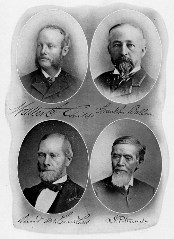
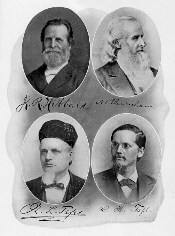
Walter C Childs, Franklin Ballou, David McCandles, J.P. Stuart
J.R. Hibbard, N C Burnham, R. L. Tafel, L. H. Tafel
Click on image for a larger version.
It was observed a hundred years ago that there existed two classes of professed New Churchmen, radically diverging from one another: those who acknowledged and those who denied the two fundamental principles which have been described above. From the beginning there had been those who, while admitting that Swedenborg's Writings were in general true, and indeed most beautiful and edifying, nevertheless maintained that they were by no means Divinely inspired, or to be at all compared with Divine Revelation in infallibility or authority; as to certain teachings these Writings might be antiquated or even utterly wrong, and therefore subject to the discriminating judgment of human reason in the light of modern science and philosophy. These persons were also opposed to the distinctive establishment of the New Church as separate in worship from the sects of the Old, or they looked upon the external organizations of the New Church as a merely temporary necessity, believing that the spiritual condition of the Christian world at large was continually improving, and that the denominations of the Old Church, by an imperceptible permeation of new truth directly from Heaven, would gradually develop into churches of the New Jerusalem.
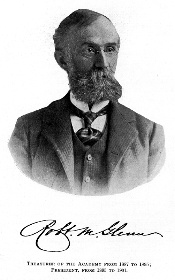
Robt. M. Glenn
Treasurer of the Academy from 1887 to 1895,
President, From 1895 to 1901.
Click on image for a larger version.
But from the beginning there had been members of the New Church who strenuously and persistently, in the midst of great opposition, had upheld and defended the Divine Authority of the Writings and the Distinctiveness of the New Church with all consequential issues; and these persons were also the champions of the distinctive Education of the Church. Gradually, as the wave of denial of the two fundamental principles grew higher and bolder and more and more overwhelming, these defenders of the faith drew nearer together, and began to look for means for combined and more effective resistance against the spirit of destruction which had invaded the Church.
Thus it happened that on the Fourteenth day of January, in the year 1874, four members of the New Church, Messrs. Benade, Pitcairn, Childs and Ballou, met together in Pittsburg in order to consider what could be done to counteract the growing influence of the negative spirit in the Church. It was decided to publish a pamphlet or book in defence of the two essential principles at issue, and initial steps towards a more general organization were taken, which two years later resulted in the establishment of the Academy of the New Church. Though more or less informal, this meeting marks the first conception of the Academy, and it is therefore being commemorated annually as the "Founders' Day."
Organization of the Academy. top
The Centennial of the Declaration of Independence of the United States was celebrated in Philadelphia in the year 1876, and the fifty-sixth General Convention of the New Jerusalem met in the same city, in the month of June. After the sessions of the Convention had closed, twelve members of the Church met at the house of Dr. F. E. Boericke, NO. 222 Franklin Square, and associated themselves together in an organized body, under the name of The Academy of the New Church. The single purpose of the organization was to institute an active propaganda in the New Church for the more loyal recognition of the Divine Authority of the Revelation which had been delivered to the New Church by the Lord in His Second Advent. As the first means for this propaganda, it was decided to publish a serial journal under the title of Words for the New Church.
Before the meeting closed, attention was called to the fact that the date of organization was the Nineteenth day of June, the day when, in the year 1770, as described in the True Christian Religion, the Lord called together His twelve apostles in the spiritual world for the purpose of sending them forth to proclaim the Second Advent andl the everlasting Kingdom throughout the universal Spiritual world. This day, which of late years is being more and more generally celebrated as the natal day of the New Church, thus also is the birthday of the Academy of the New Church.
The gentlemen present at this memorable meeting were the following:
Rev. WILLIAM .H. BENADE, of Pittsburg, Pa.
Rev. JAMES P. STUART, of Vineland, N. J.
Rev. JOHN RANDOLPH HIBBARD, of Chicago, Ill.
Rev. NATHAN CLARK BURNHAM, of Lancaster, Pa.
Rev. SAMUEL M. WARREN, of Boston, Mass.
Rev. RUDOLPH L. TAFEL, of London, England.
Rev. Louis H. TAFEL, Philadelphia, Pa.
Dr. F. E. BOERICKE, of Philadelphia, Pa.
Mr. DAVID McCANDLESS, of Pittsburg, Pa.
Mr. JOHN PITCAIRN, of Pittsburg, Pa.
M r. WALTER C. CHILDS, of Pittsburg, Pa.
Mr. FRANKLIN BALLOU, of Pittsburg, Pa.
One of the twelve members soon afterwards withdrew from the Association, but his place was filled by the Rev. WILLIAM F. PENDLETON, of Philadelphia, Pa., whose name appears as one of the signers of the Charter of the Academy.
The Academy Enters Upon the Use of Education. top
The use originally adopted by the Academy was one of doctrinal propaganda. The use of Education, and especially the establishment of a Theological School, was indeed in the minds of the members, but was considered at the time as a rather remote possibility. But through the evident leading of Divine Providence, the Academy was soon led to enter upon the work which was to become its distinguishing use.
The establishment of the Theological School and the College of the Academy was caused by the desirability and necessity of centralizing the educational work which for some years had been carried on privately by members of the Academy in three different localities. In Pittsburg Mr. Benade had been giving theological instruction to two young men who had come to him to be prepared for the Ministry of the New Church. In Philadelphia Rev. Louis H. Tafel, assisted by Rev. W. F. Pendleton, had been doing the same service for five candidates for the Ministry, and in New York Rev. Leonhard Tafel had been giving instruction in the sacred languages to three young men who also intended to prepare themselves for the Priesthood of the New Church.
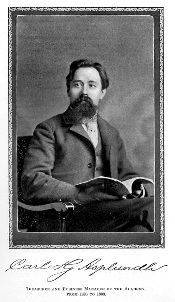
Carl H. Asplundh
Treasurer and Buisiness Manager
of the Academy,
from 1893 to 1903.
Click on image for a larger version.
As, now, the Academy recognized that the aims and object for which it had been organized could be accomplished ultimately only by priesthood thoroughly inspired by loyalty to Heavenly Doctrines and carefully prepared by a systematic study of these Doctrines, and as it was evident that far better results could be gained by a combination of the teaching forces than by individual efforts, and as finally the means for this end were now beginning to be provided, preparations were made for the establishment of a central Theological School in the city of Philadelphia. And as a thoroughly prepared Ministry involved a previous training in Science and Philosophy, considered in the light of the New Church, a preparatory Collegiate department also became a necessity. Application for a Charter for the intended educational institution was made to the State of Pennsylvania, and the "College and Divinity School" of the Academy was opened in the building on Cherry Street, in Philadelphia, on September 3rd, 1877.
The Schools at Cherry Street. top
The Schools opened in a very modest way, indeed, with eight students in the two departments, and with a Faculty of one resident and two visiting theological professors, assisted by four more or less occasional lecturers. There was little of the usual equipment and paraphernalia of a school, but there was present a spirit of loyalty, devotion and determination, which carried within it more promises for the future than any amount of property and endowments could have given.
In the absence of Mr. Benade, the Chancellor or President of the Academy, who was engaged in an extensive journey through Europe and the Orient, the opening address was delivered by the Vice Chancellor, the Rev. J. P. Stuart. On September 11th, the students organized a debating club, or intellectual "Gymnasium," and on November 3rd, the Academy received its Charter from the State of Pennsylvania. These were the chief events of the first school year, which closed with "Commencement" exercises on May 15th, 1878. The second year opened on October 1st, 1878, with twelve students, and closed on May 15th, 1879, when the degree of Bachelor of Arts was granted to the first two graduates of the Academy, Mr. E. C. Bostock and Mr. John Witehead. On September 8th, the Schools were opened by Mr. Benade, who had now returned from his journeys to take immediate charge of the direction of the school work. At the close of the third year, on June 3rd, 1880, the first degree of "Bachelor of Theology" was granted to Messrs. Bostock and Whitehead. The great event of the fourth year was the publication of the first number of New Church Life, on January 1st, 1881. The journal was intended to be a paper for the young people of the Church, and was edited by Mr. E. P. Anshutz, with the active assistance of three of the Academy students; it soon ascended into more serious planes of thought, and in 1890 was adopted as the official organ of the Academy.
In 1881 the theological and the collegiate departments removed to No. 110 Friedlander Street, and a Boys' School was established, using the Cherry Street building. The following year a Kindergarten department was also added, and at the same time Mrs. Sarah D. Hibbard opened a private school for young girls at her residence, 2040 Cherry Street, which school in 1884 was taken charge of by the Academy and is now known as the "Girls' Seminary."
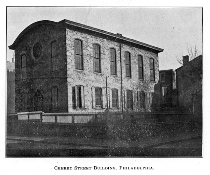
Cherry Street Building, Philadelphia
Click on image for a larger version.
But the schools continued to move from one place to another. In 1884 the Girls' School an Kindergarten moved to No. 2027 Vine Street. The following year all the departments were transferred to a large residence, No. 1700 Summer Street, with the exception of the Boys' School, which remained on Cherry Street. Again, excepting the Boys' School, all the departments removed to No. 1821 Wallace Street, in May, 1887. Here a large double residence with quite extensive grounds had been purchased by the Academy. At the rear of the lot there was a stable facing North Street, which, during the ensuing summer months, was rebuilt and fitted up into a very commodious house for the Boys' School. The third story was arranged into a spacious Hall of Worship. The two school houses were solemnly dedicated on January 3rd, 1888. Only once more were the Academy Schools to move, and this tune to the country. For some years it had been the intention of the Academy to locate its schools somewhere in the country in Academy neighborhood of Philadelphia, and finally the beautiful district around the village of Huntingdon Valley was chosen. Here land was purchased and first a school for young children established; but on April 20th, 1898, all the departments left the city and the Academy moved into its new building, now occupied by The Inn.
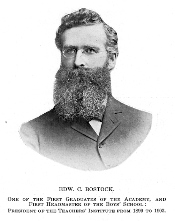
Edw. C. Bostock
One of the First Graduates of the Academy, And
first Headmaster of the Boys' School:
President of the Teachers' Institute from 1899 to 1903.
Click on image for a larger version.
Then in 1901 the present College building was completed; also "Glenn Hall" and the janitor's home. In 1904 "Stuart Hall," the Dining Hall and the Power House were built, establishing all the departments in commodious, pleasant, well-built structures. In the meantime the work of the Academy was placed on a secure financial basis by the Endowment Fund, which was received on January 29th, 1899.
Now let us go back and see what has been the internal growth, and what marked changes have been made in the organization and government of the Academy.
During the years 1883 and 1884 Bishop Benade gave a long series of lectures or "Conversations" on Education, which were destined to have a powerful and far-reaching effect on the educational work of the Church and of the Academy itself. In fact, today the work of the Academy is modeled on the principles which were then laid down, although there has necessarily been some modification and further development due to practical application.
In 1888 local schools were established by the Academy in Chicago and Pittsburg. It was recognized that every centre should have its own school, but as none of the centres were then strong enough to support schools, the Academy undertook this work. Later it also established schools in Berlin, Toronto and Huntingdon Valley. In 1896, however, the Academy gave up this undertaking and these various local schools passed into the immediate control and support of the socieites where they were located. The last school from which the Academy withdrew its support was the Boys' School in Philadelphia, which was not discontinued as a department of the Academy until October 4th, 1897.
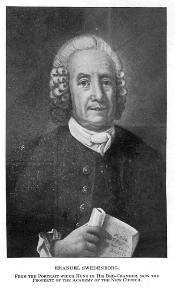
Emanuel Swedenborg
From the Portrait which Hung in His Bed-Chamber, now the
Property of the Academy of the New Church.
Click on image for a larger version.
In 1896 the Corporation of the Academy was generally reorganized and a Board of Directors was elected. The departments of the schools were also more distinctly organized. On February 7th, 1897, Bishop Benade withdrew from the Chancellorship of the Academy, and all the departments of the schools were temporarily closed by the Corporation, pending further reorganization. Under the general supervision of the Rev. William F. Pendleton, the Bishop of the newly-organized General Church of the New Jerusalem, the school work was, however, continued independently and without interruption at Huntingdon Valley, where most of the professors and teachers now resided.
In the Fall the schools were reopened by the Academy, and Bishop Pendleton was given general charge as Superintendent, which office he held until 1903, when he resigned, and the Faculty was placed in charge of the College and Seminary. In 1904 the Board of Directors established a Normal Department, with the Rev. Homer Synnestvedt as principal.
Social Life. top
One of the important features of the Academy schools has been social life. Perhaps this commenced with the "Gymnasium" or debating club mentioned above, but the first real development was while the schools were located in Summer Street. In 1887 the schools for the first time celebrated Swedenborg's birthday, which was, as far as is known, the first celebration of that event in the history of the New Church, though the celebration held the following year was a more memorable occasion, as it was the bicentennial of Swedenborg's birthday, and cablegrams were exchanged with the Royal Academy of Sciences in Stockholm, where the event was publicly celebrated.
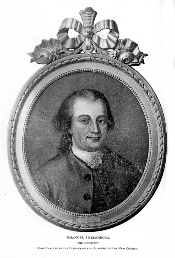
Emanuel Swedenborg,
The Scientist.
Now Hanging in the Library of the Academy of the New Church.
Click on image for a larger version.
Gradually the social life increased in activity until the Academy schools had their own distinctive social life, celebrating Swedenborg's birthday and other important events annually, also holding the opening and closing exercises with more or less ceremony. Alumni and Alumnae associations have been formed, and though they have not yet been able to do much they have made a beginning and are looking forward to greater activity.
By the Divine Providence the Academy schools are thus equipped with the external instrumentalities for carrying on their work. They are beautifully situated, possess broad lands sufficient for great expansion, and are capable of well caring for students and pupils.
The prayers and hopes of the Academy are for spiritual blessings, the increase in wisdom and the love of use. This hope is based upon the belief that there still dwells with the institution the same spirit which has characterized it from the beginning, the spirit to abide loyally in the Heavenly Doctrines of the New Jerusalem, and to adhere to the ideal of New Church Education which is there revealed to those who seek it.
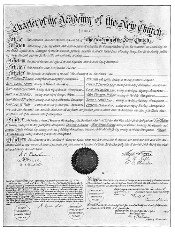
The Academy Charter
Click on image for a larger version.
Our own Academy. top
What name resounds more sweet than Thine,
Beloved School! For gifts Divine,
For life and light received through thee,
We render thanks, Academy!
Alma Mater. top
What name resounds more sweet than Thine,
Beloved School! For gifts Divine,
For life and light received through thee,
We render thanks, Academy!
CHORUS.
Dear Alma Mater, hear our song!
Our love and trust to thee belong!
Firm ever sand thy sons to guard thy name;
And true thy daughters watch thy sacred flame!
May thy beloved altars stand
Through every age, in every land!
And may thy heavenly uses be
Forever blessed Academy!
CHORUS.
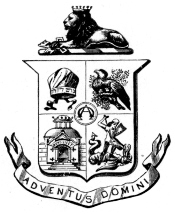
The Academy Seal
Click on image for a larger version.